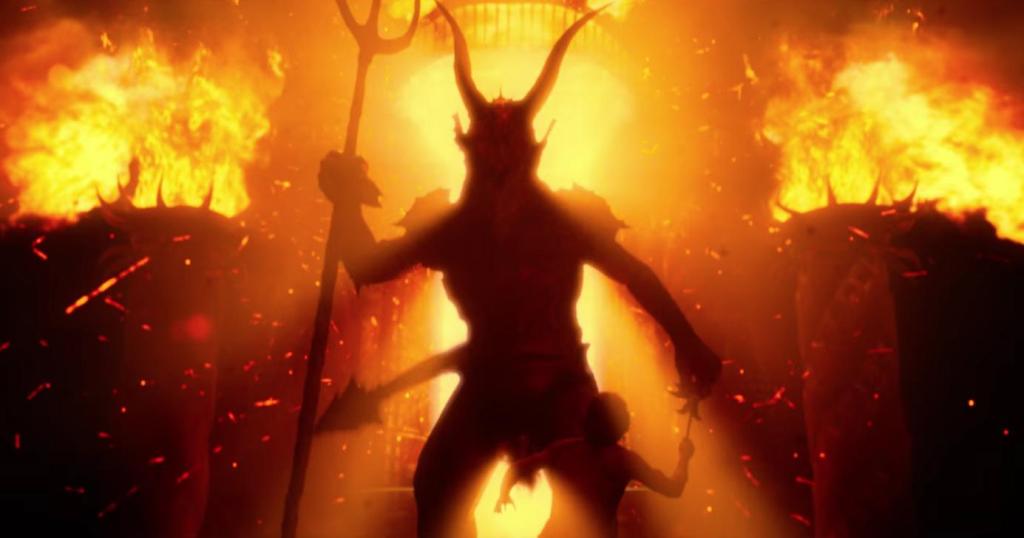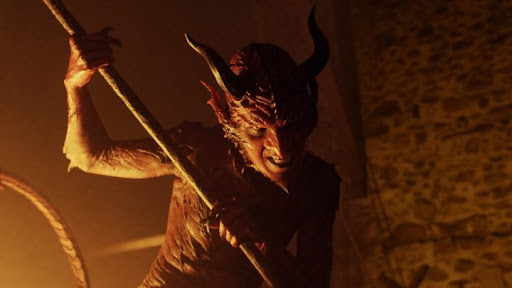It’s not every movie that causes me to look up some history. Well, that’s not exactly true, I’m always trying to find info on the history of the movie itself, but this time I’m talking about History with a capital H. To be exact, the prologue tells us it takes place during “The First Carlist War”, an event about which I am woefully uninformed. Anyway, here is the Wikipedia entry on the subject if you have a similar hole in your education.
So we’re in the late 1830’s in the Basque region of Spain, and some Carlists are about to be shot for attempting to smuggle Tsarist gold for the cause. One of the Carlists manages to survive the firing squad and murder all the liberal (hey, history’s label, not mine) soldiers. A devil’s silhouette is briefly seen in the havoc.
Eight years pass, and a representative from the government arrives in a small rustic Basque village. He’s looking for that gold, and some of the greedy villagers are all too willing to help him. The primary suspect is a blacksmith, Patxi (Kandido Uranga) who returned from the wars eight years before and has turned his smithy into a fortress, festooned with iron spikes, crosses and bear traps. Patxi is, in short, the local boogyman, feared by children and spoken of only in whispers.
The other major character will be Usue (Uma Bracaglia), an orphan girl with a burn scar on one side of her face. Circumstances – by which I mean the casual cruelty of the other village children – cause her to venture into Patxi’s domain, where we will find out that the blacksmith has a literal devil held prisoner in an iron cage.

As you surmised, Patxi is the survivor of that firing squad at the beginning, and his survival is due to a deal made with that devil that he could go back home to his wife. The deal, of course, goes sour as such diabolical contracts do, and Patxi is determined to put off his part of the bargain as long as possible. He captured his devil (who shows himself to be something of a klutz, so small wonder) and has fortified the smithy against other devils coming to his prisoner’s rescue.
This revelation comes fairly early, and the rest of the movie picks up the threads and weaves them into a complete fable. There are many discussions with the captive devil, Sartael (Eneko Sagardoy), who proves to be a joy, if a venal, abrasive one.
Things come to a head when the village, thinking they are rescuing Usue, form the traditional torch-bearing mob to storm the smithy and discover Sartael. Even then, things do not quite work out as expected.
Errementari (which is Basque for blacksmith) is one of Netflix’s foreign imports, and I have to say I’ve been impressed with each one I’ve seen. Production values are rich, and the whole thing has the feel of a story handed down in the oral tradition – the pieces all fit together like an old, comfortable hand-carved wooden puzzle. The makeup on Sartael is excellent – it has to be, we see it so much – and when we do finally visit Hell, it is based on woodcuts and paintings of the infernal region and its denizens, quite something to see.

Modern Spanish horror has a definite feel about it; I think I would have placed its origin correctly without even knowing. The language, incidentally, is Basque (even for the Spanish officials), and that is particularly satisfying, considering it was forbidden under another dictatorship, Franco’s. I found the whole thing quite delightful and have no hesitation recommending it.
Leave a comment
No comments yet.





Leave a comment